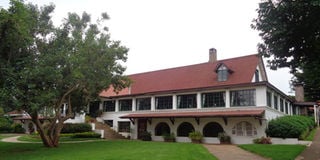Birding in Tigoni

The dining Room and restaurant at Brackenhurst Hotel. PHOTO | RUPI MANGAT
What you need to know:
- Strolling along the flower beds that have recently been planted with indigenous species of Impatiens (also called Busy Lizzie) – there are 25 species from the Eastern Arc mountains – these cute little flowering plants have been bred by horticulturalists into big showy flowers commonly seen on the roadside nurseries in Nairobi and other urban centres.
- By now we’re at the Brackenhurst Botanic Garden signboard with indigenous trees planted 15 years ago by Nicholson, when a common scimitarbill is seen at close quarters – its bill curved like the scimitar from the Middle East – a backsword with a curved blade.
It’s a grey May day morning, driving from Nairobi to Tigoni, 35 kilometres away on roads that have seen better days.
The scene changes from the poorly planned towns fringing Nairobi to the luscious green of Tigoni’s famed tea fields.
It’s what got the early settlers to Tigoni. I’m browsing through Brackenhurst Hotel’s history – when in 1914 the Hudson Cane family from England arrived on ox-wagon to start coffee farming in a place where the locals said nothing would grow because it was so full of mist.
A hundred (and one) years later, we’re awed by the beautifully landscaped gardens of Brackenhurst for a day of birding. Parking the cars, we watch Eastern double-collared sunbirds and Tacazze sunbirds flitting around the colourful flowers and trees. The female of the Eastern double-collared sunbird is building her nest on the higher branches of a tree while Fleur Ng’weno’s on-site commentary (she has to be the David Attenborough of Kenya) keeps us enchanted. “These are high-altitude sunbirds that we don’t see in Nairobi.”
Dr Mark Nicholson, director of Brackenhurst Botanical Garden joins in. He’s transforming the 150-acre space into an indigenous botanical garden by getting rid of the exotics.
Since the turn of the millennium when he began work at Brackenhurst, the list of bird species has increased from 30 to an incredible 187. “I like the stuff that birds like,” says the veteran botanist referring to plants.
Indigenous birds like indigenous plants over exotic plants which become troublesome invasive species costing the local economy millions of shillings in lost revenue from farming or ranching.
RARE SIGHTING
Strolling along the flower beds that have recently been planted with indigenous species of Impatiens (also called Busy Lizzie) – there are 25 species from the Eastern Arc mountains – these cute little flowering plants have been bred by horticulturalists into big showy flowers commonly seen on the roadside nurseries in Nairobi and other urban centres.
“The wild species are collected for a multi-billion dollar industry,” comments Nicholson. Indigenous species are also sought after to get the disease-resistant gene to treat the hybrid Impatiens which aren’t as hardy as their wild cousins.
By now we’re at the Brackenhurst Botanic Garden signboard with indigenous trees planted 15 years ago by Nicholson, when a common scimitarbill is seen at close quarters – its bill curved like the scimitar from the Middle East – a backsword with a curved blade.
“It’s actually not common,” remarks Fleur with her faithful binoculars in hand, while explaining the phenomenon of the bird. “They have only been recorded at Brackenhurst in the last two years.”
Their appearance may be an indicator of the upcoming forest. I’m fascinated by the new apps that digital birders carry – keeping log of what they see, where and when – while getting an instant picture of the bird.
An Augur buzzard lands on a tall post by the obstacle course for team building. A little yellow bird flies by – it’s a Montane white-eye different from the white-eyed slaty flycatcher that’s next on the list.
From this vantage point, the peaks of Ngong Hills show with the white windmills sticking out like tooth-picks.
Windmills although needed for clean energy can be disastrous for migrating birds, vultures and many other birds of prey because they are usually placed on the same wind-path that the birds like.
Newer models of windmills are built more compact to avoid bird-strikes – something that those in the Kenya energy sector hopefully are looking into.
It’s been a really beautiful day with almost 40 species recorded in a course of a morning including the rarely seen Grey-headed sunbird and to crown it all – a Blue-headed coucal.
Things to do
Brackenhurst Hotel and Conferences www.brackenhurst.com has beautiful ensuite rooms, conference rooms, nature trails for running, hiking and team building set in beautiful gardens.
Indigenous trees are on sale during weekdays. Learn which plants not to plant in your gardens –like the popular green hedge Duranta.
Sign up with Nature Kenya to make new friend and learn about the wonder world of nature www.naturekenya.org




